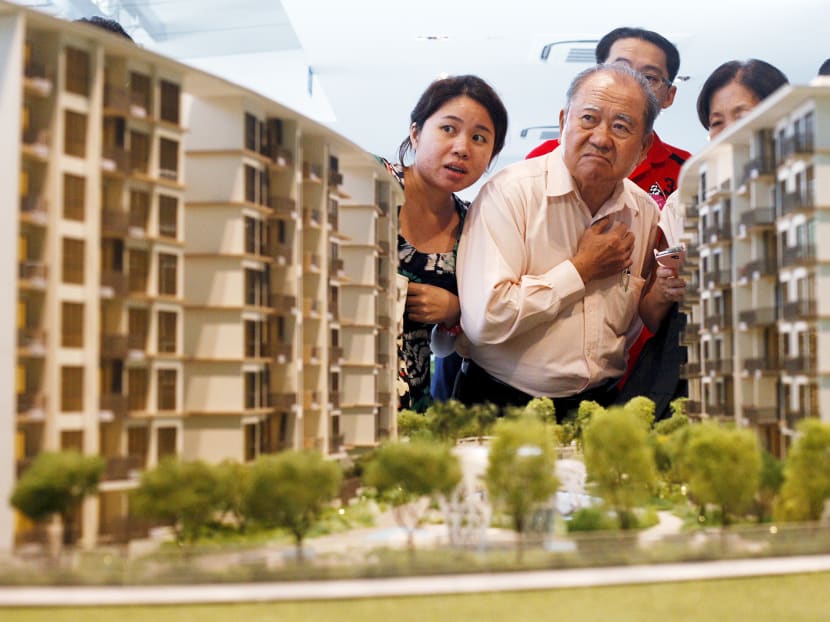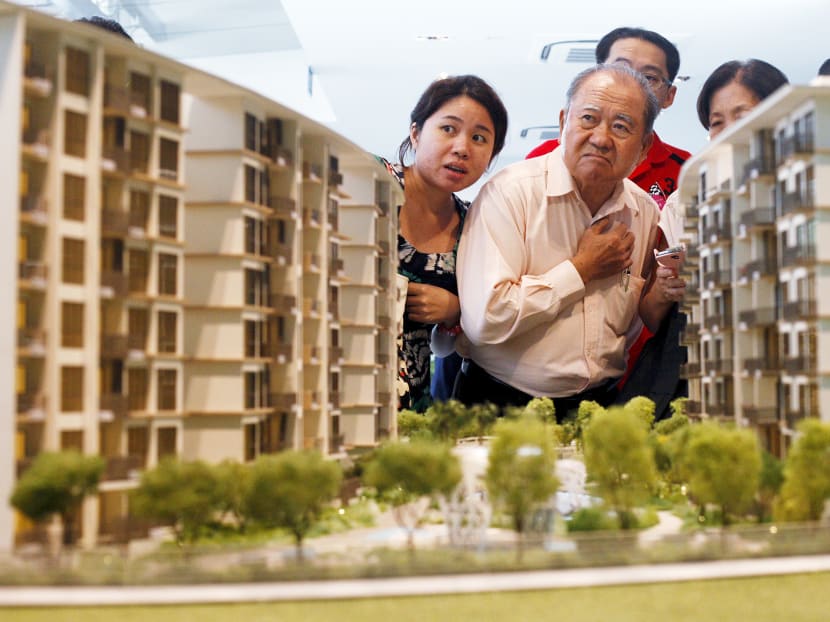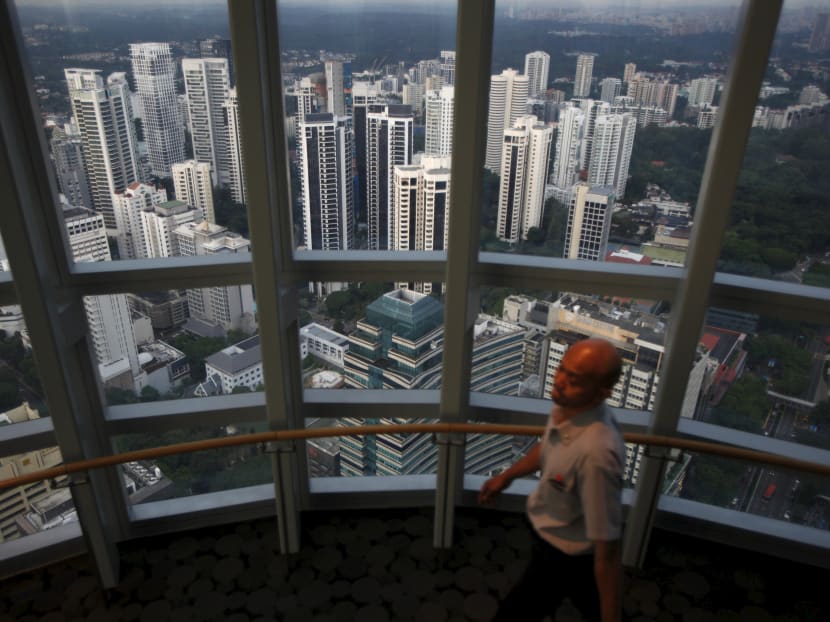More dark clouds loom for private housing market next year

Prospective buyers look at a model of a condominium development. Prices could fall by up to 8% in the next year. Photo: Reuters
jQuery.noConflict() More dark clouds loom for private housing market next year
The lacklustre economic environment is likely to depress sentiment further
Lee Yen NeeLeeYenNee [at] mediacorp.com.sg Published: Tuesday, 29 December 2015
After another year of subdued home buying activity, property analysts warned that the Republic’s private residential property market may be in for tougher times in 2016 as the lacklustre economic environment is likely to depress sentiment further.
Adding to the woes is the United States Federal Reserve’s decision to start normalising interest rates, which is expected to keep prospective buyers on the sidelines as they adjust to the new reality. That, coupled with existing property curbs, could cause prices to fall by up to 8 per cent in the next 12 months, analysts told TODAY.
“Higher interest rates coupled with cooling measures will dampen demand, perpetuate sluggish market conditions and softening in prices … In 2016, it is expected to fall by at least the same pace or faster if economic conditions worsen,” said Mr Ong Teck Hui, JLL’s national director for research and consultancy.
The 5 to 8 per cent of price moderation that analysts forecast for 2016 is quicker than the expected decline this year. Urban Redevelopment Authority (URA) statistics showed that in the first nine months of 2015, private home prices fell by 3.2 per cent and will likely end the year at about 5 per cent lower than the previous year’s level, analysts said.
Mr Ong Teck Hui
JLL’s national director for research and consultancy“Higher interest rates coupled with cooling measures will dampen demand, perpetuate sluggish market conditions and softening in prices … In 2016, it is expected to fall by at least the same pace or faster if economic conditions worsen.”
Compared with the peak in 2013’s third quarter, prices have fallen 8 per cent as of end-September and will likely inch towards 10 per cent by the end of this year. Such a magnitude of decline — though still shy of the 60 per cent surge between 2009 and 2013’s peak — may draw some potential buyers into the market and boost sales for the year.
2016 could also see some developers coming under pressure to clear inventory as their respective deadlines to avoid paying stamp duties and extension fees near. These developers may be more compelled to lower prices to meet buyers’ expectations — a move that could potentially help next year’s sales volume improve, analysts said.
Several developers TODAY approached declined to comment.
Developers are required to pay an Additional Buyer’s Stamp Duty (ABSD) of 15 per cent unless they build, complete and sell all units five years from the date of the land acquisition.
Besides that, developers with foreign holdings and not building on land sold by the Government are subject to Qualifying Certificate conditions, which require them to complete construction within five years and sell all dwelling units within two years.
“There could potentially be more transaction activity in 2016 … (But) this could be at the expense of prices. We anticipate sales only being achieved for the motivated sellers who are prepared to be realistic on price,” Colliers International told TODAY, without giving a sales projection for 2016.
But other analysts are forecasting that developers could sell anything between 7,000 and 8,000 units next year, which looks set to be an increase from this year’s sales but a far cry from the over 22,000 transactions seen during the peak in 2012.
Pending the final URA real estate statistics for 2015 due in January, developers have sold around 5,800 units in January-to-September. Analysts expect sales to total around 7,000 units this year.

Across the Republic, the Core Central Region (CCR) or city centre that has been the worst hit by the series of Government measures is expected to be more resilient next year, analysts said.
These properties were most affected by measures such as ABSD and the Total Debt Servicing Ratio (TDSR) framework given their higher price tags. Demand was seen shifting towards the Outside Central Region (OCR), or suburbs, where home prices are of smaller quantum, which supported prices in the area. However, the reverse could be seen in 2016 as prices in the city centre and city fringes have “become more attractive”, noted Mr Wong Xian Yang, senior manager of research and consultancy at OrangeTee.
Mr Wong expects CCR prices to post the smallest price decline of up to 3 per cent in 2016, while private homes in OCR would see the steepest fall of up to 7 per cent. The Rest of Central Region (RCR), or city fringes, could see prices dip up to 5 per cent.
Supporting his view is Ms Alice Tan, director and head of consultancy and research at Knight Frank, who noted that the CCR will see limited new supply in the coming years. Higher number of new completions in the OCR next year also means that rents in the suburbs are likely to lead the downward adjustment in the overall market.
In the first nine months this year, overall rents in Singapore slipped by 3.3 per cent. Compared to its peaks in the third quarter of 2013, rents have fallen for a total of 6.7 per cent in eight consecutive quarters, URA figures showed.
The number of private residences due for completion will peak in 2016 at around 22,000 units, URA said, which means the competition for tenants is set to intensify next year and vacancy rates will possibly hit double digits from the 7.8 per cent as of the third quarter 2015.
Ms Tan said: “Overall rentals of private homes could slip by 4 to 6 per cent year-on-year by the fourth quarter of 2016, in view that population growth next year is not likely to exceed the 1 per cent of annual increase seen in the last two years and with the likely continuation of tight immigration and foreign workforce polices.”

Mr Wong Xian Yang
senior manager of research and consultancy at OrangeTee“If it ain’t broke, don’t fix it... The current situation seems to be in line with the Government’s plan for a soft landing for the property market … So if the situation remains unchanged, we probably would not see a revision in cooling measures. ”
With private residential property prices softening at a moderate pace and expected to continue so next year, analysts agreed that the current situation presents “little incentive” for the Government to tweak any cooling measures.
“If it ain’t broke, don’t fix it,” said OrangeTee’s Mr Wong. “The current situation seems to be in line with the Government’s plan for a soft landing for the property market … So if the situation remains unchanged, we probably would not see a revision in cooling measures.”
Several industry players, including the Real Estate Developers’ Association of Singapore, have repeatedly urged the Government to relook the curbs as prices and sales volume have moderated. In response, the Government has also come forward to state that it is still early to review the measures, but gave assurance that it will keep a close watch of market developments.
In view of that, analysts said any adjustments would likely come in the later part of 2016.
“We do not expect the cooling measures to be revised until the Government is satisfied that prices have eased sufficiently and threats to market stability have been resolved. My view is that should there be any adjustments to the cooling measures, it is unlikely to be before the later part of 2016 or possibly beyond that,” said JLL’s Mr Ong.
Mr Ong Teck Hui
JLL’s national director for research and consultancy“We do not expect the cooling measures to be revised until the Government is satisfied that prices have eased sufficiently and threats to market stability have been resolved. My view is that should there be any adjustments to the cooling measures, it is unlikely to be before the later part of 2016 or possibly beyond that”
Nevertheless, the Government remains a party that will be keenly watched by the industry for any developments that could potentially have a bearing on the property market will be keenly watched in 2016, analysts said.
Other major factors that could affect sentiment is the macroeconomic situation and movements in interest rates.
“The Budget definitely is one key event to watch out for, as the Government may fine-tune current cooling measures. The other event is to see whether the global economy, especially China, can rebound,” said Dr Lee Nai Jia, DTZ’s regional head of research for Southeast Asia.






